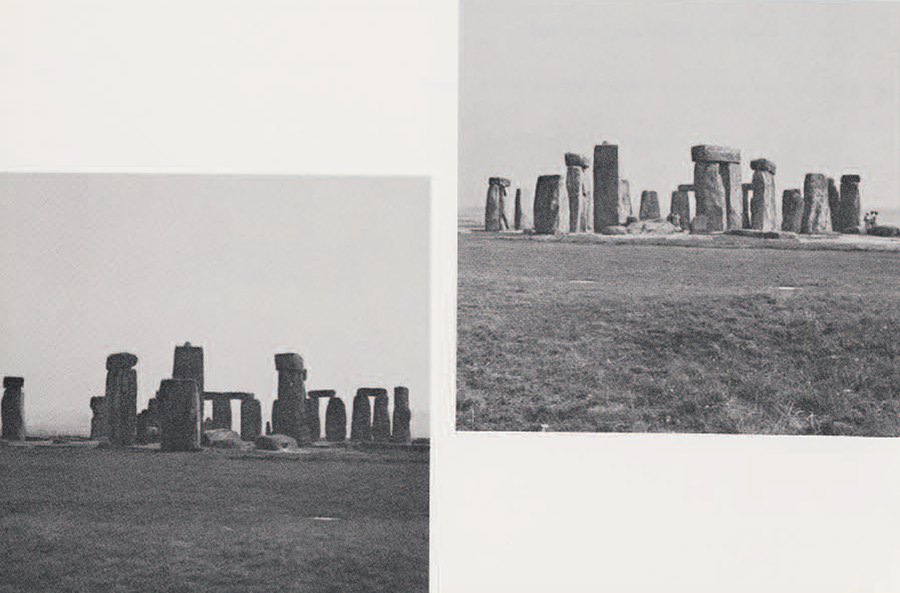 Stonehenge! The name conjures up visions of Druid priests assembling on Salisbury Plain to await sunrise on Midsummer’s Day. But Stonehenge was built long before the time of the Druids. And while the carefully constructed circle of carved sarsens (large sandstone blocks, “Druid Stones”) and lintels is unique, in other features Stonehenge is merely one example of a class of similar Neolithic and early Bronze Age structures. Called “henges” after Stonehenge, though lacking the “hanging” stones from which this name derives, some are even more spectacular in their own ways. Their exact number no one knows. At present almost one hundred are known throughout the British Isles, but perhaps as many more remain to be identified or have long since vanished under the hands of farmers or town builders in the three to four thousand years that have passed since their construction. Still, each year a few new examples are discovered or recognized for what they are.
Stonehenge! The name conjures up visions of Druid priests assembling on Salisbury Plain to await sunrise on Midsummer’s Day. But Stonehenge was built long before the time of the Druids. And while the carefully constructed circle of carved sarsens (large sandstone blocks, “Druid Stones”) and lintels is unique, in other features Stonehenge is merely one example of a class of similar Neolithic and early Bronze Age structures. Called “henges” after Stonehenge, though lacking the “hanging” stones from which this name derives, some are even more spectacular in their own ways. Their exact number no one knows. At present almost one hundred are known throughout the British Isles, but perhaps as many more remain to be identified or have long since vanished under the hands of farmers or town builders in the three to four thousand years that have passed since their construction. Still, each year a few new examples are discovered or recognized for what they are.

Many of the henges now known, and almost all of those discovered recently, were brought to the attention of archaeologists through aerial photography. The first identified by this means was Woodhenge, a monument originally built of wooden posts and located less than two miles from Stonehenge (hence its name); it was long considered a much-eroded disc barrow or burial mound. In 1925, G.S.M. Insall noticed that from the air it closely resembled its neighbor, and a photograph taken by him the following year showed the same low bank with inside ditch plus six concentric circles of what appeared to be post holes. Almost immediately, excavations were begun that bore out the evidence of aerial observation, prompting the suggestion that this monument had been built as a model for its stone parallel. This cannot be proven, but it is true that in both cases the axes of the circles (though at Woodhenge not the entrance through the bank) are oriented roughly toward the point of midsummer sunrise. Woodhenge is further distinguished by having near its center a burial cyst in which was found the skeleton of a small child with its skull cleft; this seems almost certain to have been a sacrifice made in dedicating the monument.
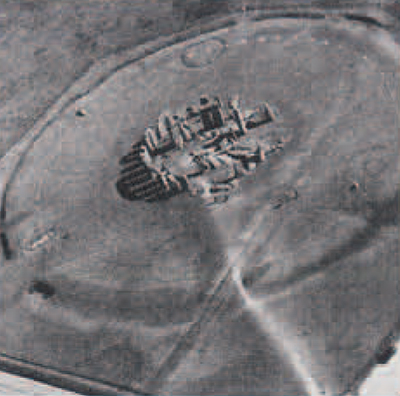
Just what was the purpose of the henges? What could have compelled the people of that long-ago time to expend the vast amounts of labor that construction of these monuments required? No one knows, although the monuments seem to have been for ceremonial or religious rather than military or domestic purposes. They all have a profusion of burial mounds nearby and most of those excavated, including Stonehenge, have contained burials within their central area. But in some cases it appears these may have been made after the sites ceased to be used for other purposes, just as even today the interiors of abandoned churches in the British Isles are used as burial grounds because of the supposed greater sanctity of these areas. Fargo Plantation, a miniature henge monument only thirty feet in diameter, was apparently built in imitation of the larger henges specifically as a burial place. It was constructed early in the Bronze Age at the time of the wealthy Wessex merchant kings who built the final stage at nearby Stonehenge, and in its center was a square grave containing parts of a skeleton and a pot of the Beaker type.”Henge” in its strictest sense is usually taken to exclude those few similar monuments dating to the Middle Bronze Age or later (as does the sarsen setting at Stonehenge). These survivals usually resemble the early single-entrance henges, both in design and in containing material that suggests a connection with the so-called Secondary Neolithic rather than the Beaker cultures. But since they apparently served a function similar to that of their predecessors, there seems no sound reason to exclude them solely on the basis of their dates.The sacred nature of these circular sites. whatever their age, is further suggested by the fact that many early British churchyards and monastic sites were bounded by circular enclosures and that in one case at least—the central monument at Knowlton—this enclosure was one of the ancient henges, while at others a henge lay nearby. The practice, standard in many parts of the world, of building early churches on the site of earlier pagan temples seems to lend credence to that interpretation here as well. There is a gap of hundreds of years between the construction of the most recent of the accepted henges and that of the first churches, but circular structures that seem in some ways similar to the henges were built well into the Iron Age. Even in the Middle Ages Stonehenge was reputed to be the burial ground of ancient kings.
The earliest stage of Stonehenge, a simple bank with internal ditch, has been dated to over 4,100 years ago, but the latest stage, the trilithons, is several hundred years more recent. It would not be unusual for the reputation for sanctity of these monuments to have persisted in local legends for a thousand years or more beyond the time they ceased to play an active part in the local religion (and we have no way of knowing that they did not continue to play such a part long after they were built.) Some of these sites have, in fact, been held in a good deal of awe by the people living nearby until the present. Where this is so, it has contributed to their preservation; others have almost completely disappeared through removal of stones, deliberate leveling, and plowing by the less superstitious.
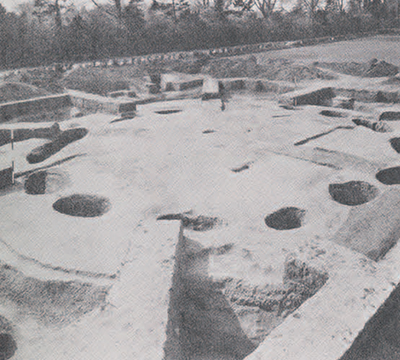
To the Roman conquerors these monuments had no such sanctity. Maumbury Rings, at Dorchester in Dorset, was converted into an amphitheater. Since this operation involved the removal of almost twelve feet of the topsoil and chalk bedrock from the internal area, it destroyed any evidence that may have existed for central features such as standing stones or post holes. Maumbury Rings was first brought to modern scholarly attention when noticed by Sir Christopher Wren on his journeys to Portland to obtain stone for building St. Paul’s. This was not long after the site had been further damaged by its use as a Parliamentary fort in the English Civil War, when internal terraces and a gun emplacement opposite the entrance were constructed.
Despite these depredations the site provides information of interest, in this case connected with that found at another Dorchester, near Oxford, where, as at Maumbury Rings, the banks of the henges were formed of earth excavated not from a ditch but from a circle of pits. In the bottoms of some of these were found what appeared to be post holes that had never held posts, though there is some evidence that burnt or liquid material may have been put into them. This in turn is reminiscent of a practice known from the eastern Mediterranean where pits known as bothroi were dug as a means of communicating with the gods of a nether world whose domain was being disturbed by digging. Certainly later, in the Iron Age, sacred wells into which offerings were thrown were common in the west.
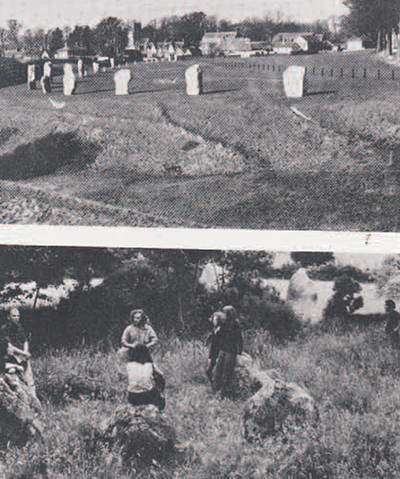
The first stage at Stonehenge also provides evidence for the practice of digging ritual pits in connection with the henges. Inside the ditch is a circle of fifty-six, called the Aubrey holes after their discoverer, which were apparently refilled soon after being dug. Some of these appear to have been redug later, and most contained cremation burials. (Recently some astronomers have suggested that these were instead sockets for moveable posts used in the prediction of eclipses of the sun and moon, but this doesn’t seem to fit well with the burials and refillings.)
The pits and ditches of the henges were dug with antler picks, many of which have been found in the ditch bottoms. Since the ditches were often of considerable depth (thirty-five feet at Maumbury Rings), these provide a good indication of the difficulty of the labor that went into construction of these monuments. Another is the size of one group of henges whose importance has only recently become apparent: Durrington Walls, Marden, Avebury. Mount Pleasant, and perhaps Waulud’s Bank. These range from just over 3,000 feet to almost a mile in circumference.
Avebury, the only other henge whose fame approaches that of Stonehenge, is large enough to contain a village. Like Stonehenge, it was studied by the seventeenth-century antiquary John Aubrey. who was asked by Charles II to conduct a guided tour of the site during a royal journey to Bath in 1663. From this tour came the further commission to produce a surveyed plan and description of the henge and the other monuments of the Avebury complex, the first careful, though superficial. study of any of these sites. Avebury differs from the other henges in having four entrances rather than only one, as the earlier henges do, or two, as do most of the later ones. It also contained two stone circles, each larger than Stonehenge and here predating the bank and ditch. To the south is the West Kennet Avenue, outlined by a double line of standing stones extending nearly two miles to the Sanctuary—two concentric stone circles and post holes for six wooden ones—on Overton Hill. When the vast circular bank was constructed (at least fifty feet from ditch floor to bank crest and 1,400 feet in diameter). a ring of 100 stones was set on its inner margin.
There were attempts during the Middle Ages to remove the standing stones at Avebury or bury them below the plow zone. It appears that this was not done for land clearance purposes but instead probably because the stones were a symbol of the old religion and therefore considered the work of the devil. Whatever the reason, the effort proved very unlucky for an itinerant barber-surgeon in the early 1320’s. While he was trying to finish the burial pit for one of the stones, it toppled, breaking his neck and trapping his body beneath it. His skeleton, complete with the remains of a leather bag containing his scissors, a lancet, and three coins of Edward I, was found in 1938 during excavation and restoration work on the site.
John Aubrey felt Avebury was far more impressive than Stonehenge, and his view has been echoed more recently by the British archaeologist Grahame Clark, who calls it “the most outstanding monument of prehistoric antiquity in Europe.”
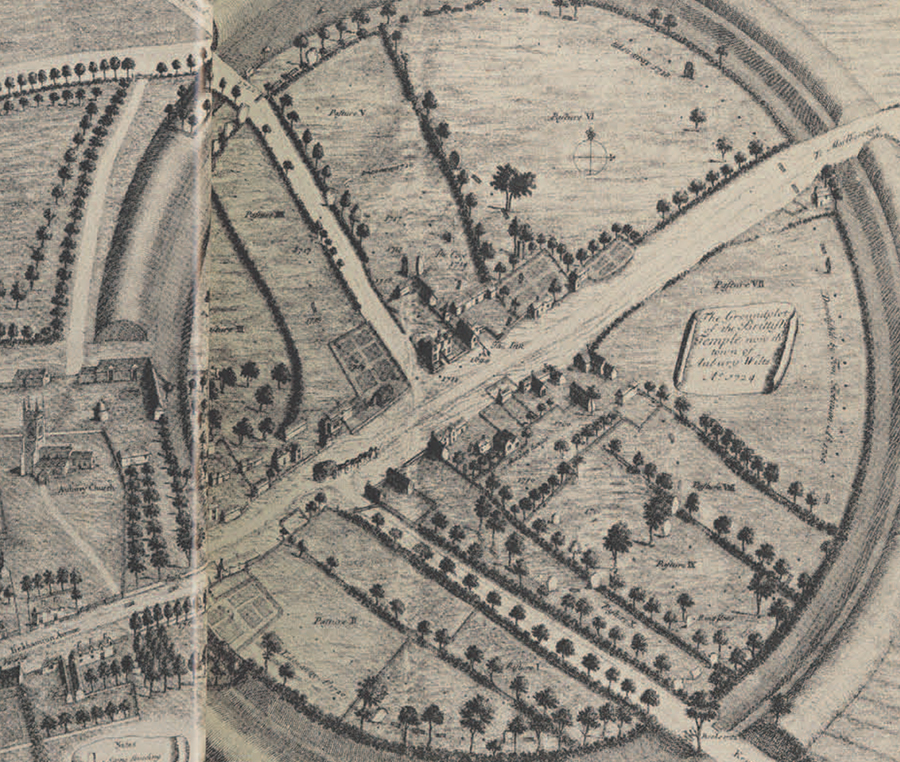
Durrington Walls, first recorded by Sir Richard Colt Hoare in 1812, may have been the main element in a complex that includes Stonehenge, Fargo Plantation, and Woodhenge as well as the Cursus—a narrow strip of land about two miles long bounded by a bank and ditch—and numerous burial mounds. Only 300 feet from Woodhenge, it seems to have been built at roughly the same time as the final bluestone stage at Stonehenge, less than two miles to the south. Only a small portion of this monument, which exceeds Avebury by almost 200 feet in diameter. has been excavated: a strip threatened by plans to shift the path of a road running across the site. In this strip was found the post-hole evidence for two circular buildings; in each case one phase of the building had included a horn-shaped facade in front of the entrance. Durrington Walls differs from the other henges in the quantities of potsherds found within it. On a hard-packed platform outside the entrance to one of the settings of post holes was found over a hundred pounds of broken Neolithic pottery, more of this particular type than is known from all other sites yet excavated.
Both Marden, located between Durrington Walls and Avebury. and Mount Pleasant, in Dorset near Maumbury Rings, have been partially obliterated by plowing, but both are still recognizable as giant henges. It is only recently that Waulud’s Bank has been proposed as a fifth. The purpose of these large henges is not clear, but it is possible that they were not only ceremonial sites but also provided a location for local fairs or other assemblies.
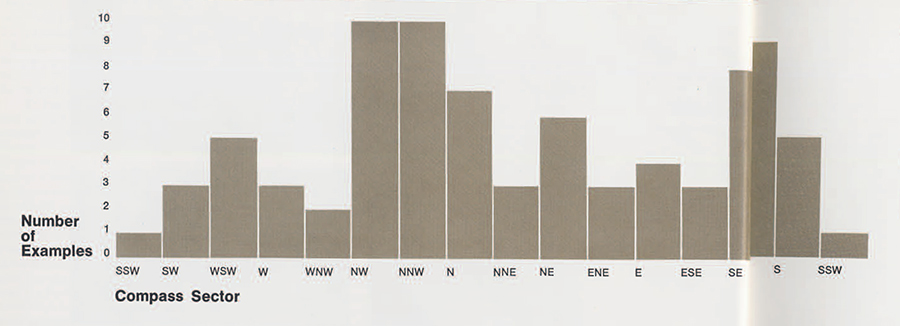
One characteristic of the henges is that they are usually located near a stream. Waulud’s Bank fulfills this criterion admirably since the River Lea rises within it. Of the other large henges, Durrington Walls and Marden are both near the Avon, with the river forming one side of the latter, perhaps having washed away the bank, and Mount Pleasant is near the Frome. Among the smaller henges, Arminghall lies on the flood plain of the Tas just below its junction with the Yare; the Dorchester group in Oxfordshire are near the Thames; King Arthur’s Round Table and May-burgh are between the Eamont and Lowther rivers just above their junction, and Mayburgh in fact tacks a ditch because its banks have been built of stones from the beds of the two rivers. A number of the other henges are similarly located near major streams or rivers.
The henge monuments are usually broken down into two classes, according to whether they have one entrance or two diametrically opposed, although as mentioned earlier Avebury has four. Because of the supposed orientation of the Stonehenge entrance toward the midsummer sunrise, much attention has been directed to their placement in the others. The tendency toward a northerly or southerly orientation for the entrances is clear in most, but the northern entrances are usually in the north-northwest and the southern in the south-southeast rather than in the northeast-southwest line that would result if midsummer sunrise were really the determining factor. This does not, however, by any means rule out an astronomical significance for the stone and timber circles the henges sometimes contain, as evidence for some astronomical use for these continues to accumulate.
There does appear to be some connection between entrance orientation and cultural affinities of the henges. The early sites usually have only a single entrance and those whose builders left traces of themselves in a type of pottery called Rinyo-Clacton Ware seem to have a random orientation.
In a number of cases henges have been built in groups of two or more, as was the case with the stone circles within the henge at Avebury. Three monuments in a line have been identified at Thornborough, Priddy Circles, and Knowlton; and Woodhenge forms such a line with two structures within Durrington Walls, though this may not be by design. The orientation of these lines parallels that of the entrances.
Just as we are not yet certain of the significance of the orientation of entrances and groups, we cannot say what part the bank and ditch themselves played in the beliefs of the builders. It has been suggested that in the early henges, with segmented ditches composed of a series of pits, the pits were the important element, serving to mark the boundaries of a sacred area. This might also serve to explain the consistency with which the dirt is piled outside the ditches, since that refuse area would not be sacred. The lack of artifacts from most of the excavated earlier henges also suggests that an effort was made to keep their interiors clean. But some investigators have claimed that the fact that the early ditches were discontinuous merely proves that the bank was the important thing. Certainly in the later monuments the bank seems to have held primary importance, though perhaps this is the result of changing beliefs by virtue of the fact that from a distance the bank becomes the most obvious feature of the monument. Mayburgh, as already mentioned, has no ditch at all, having been built of stones from the beds of the two rivers between which it stands. However, the same procedure would have been possible at the nearby King Arthur’s Round Table where the usual ditch was dug. In some of the later double-entrance henges. such as those at Thornborough and on Hutton Moor as well as Big Rings and Arminghall, there are two ditches, one inside and one outside the bank. At other sites a second ditch seems to have been added later, possibly to provide material for rebuilding an eroded bank.
Those who support the theory that the bank is the primary element have proposed a number of explanations. One holds that the bank served as a grandstand for spectators to the ceremonies being performed in the central area, A variant on this suggests the ditch was inside in order to serve as a barrier between the spectators and the hallowed ground. A second theory is that the material of the bank is hallowed by virtue of coming from the ditch and that the builders wished the visible boundary of the monument to be from sacred material (a theory that doesn’t leave out Mayburgh since rivers and stones, like wells, were held to be sacred in pagan Britain). In all likelihood we will never know the true explanation.
As mentioned, most of the henges either had burials within them or are surrounded by barrows (burial mounds), or both. Some seem to be primarily cemeteries and it is possible that the smaller henges were, like Fargo Plantation, meant as burial grounds designed to resemble temples. Besides the simple burials, it is possible that Woodhenge was not alone in having a dedicatory sacrifice, since in many cases cremation burials were found in or near the ring of pits found in some of the earlier sites and in the center of others. There is also a tendency, probably associated with the beliefs that influenced entrance orientation, for the burials to cluster near the entrances or, in the case of some single-entrance monuments, diametrically across the site.
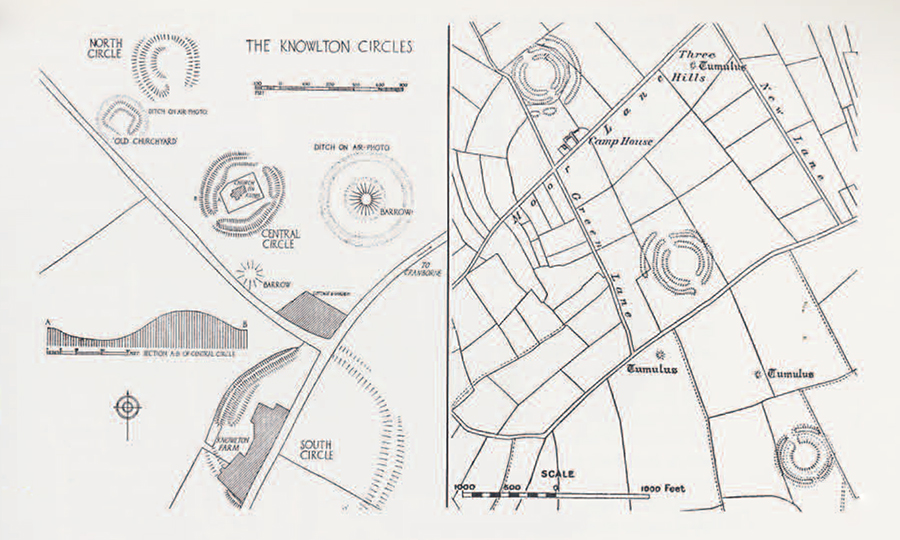
The connection between stone circles and henge monuments is another subject offering much room for speculation. On the evidence available, the circles all seem to be later than the earliest henges, and the circles, as well as an assortment of stone alignments, avenues, and other forms, are more often found without a surrounding bank and ditch than with. There may be as many as nine hundred circles in the British Isles, but less is known about these than about any other class of prehistoric monument (though there is no lack of offered explanations). It seems certain that they served a religious or ceremonial function, perhaps astronomical as well. However, it isn’t even clear that all have the same cultural origin. There is some evidence that in Scotland they developed as progressive modifications of the Hebridean round-chambered cairns and their surrounding curbs, but in the south of England the idea apparently arrived with the Beaker people. And yet a third suggestion is that they represent a later version of early wooden structures.
Many of the henges have yet to be excavated, so we do not know if they all contained wooden or stone circles, but of those excavated, only Gorsey Bigbury lacked signs of any internal structure. The signs from the others, however, do not all indicate that circles were the only type of internal feature used. Also found are “coves,” single central monoliths, horseshoe arrangements, cairns, and barrows.
In addition to the circles and barrows often found near henges, there are other types of monuments that frequently lie close by. The first of these, avenues, usually served to connect a henge with another nearby monument, as at Avebury or Broomend of Crichie. There was also a short avenue leading away from one of the circles within Durrington Walls, and at Coupland what has been called a “droveway” passes through the entrances and completely across the monument. All these are assumed to have been processional ways, but their construction varied. The Stonehenge example is defined by two small earthen banks with external ditches; others were marked by parallel stone rows.
A second class of monument found near (in fact often overlapped by) henges is the cursus (so-called from the name given the one near Stonehenge by William Stukeley in the eighteenth century). These seem to have preceded the henges in some cases and to have been roughly contemporary in others. Typically a cursus is marked by long parallel embankments, often over a mile in length, with closed ends. They look somewhat like avenues but seem to lead nowhere. Among the henges with which they are found are the early sites of Dorchester and Maxey.
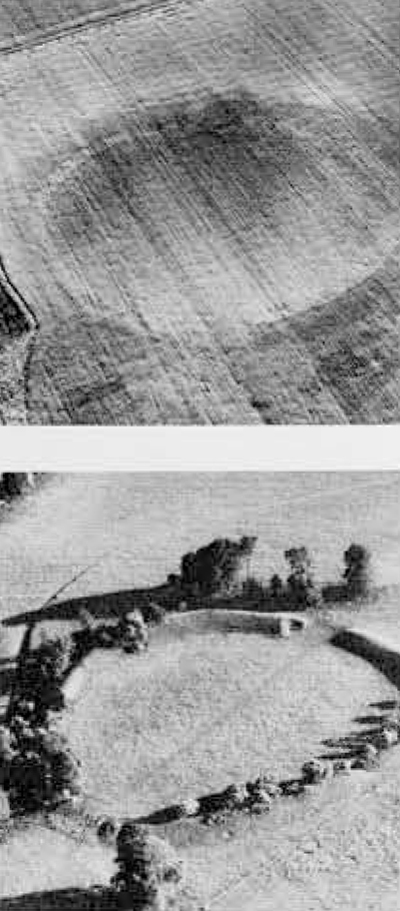
I have already suggested that differences in henge structure may indicate different time periods or different cultural affinities. These differences can be useful in answering certain other types of archaeological questions. In particular, they allow us to speculate about the origin of the henges and their connection with later monuments and they give clues to trade routes and migration patterns. In the first instance the segmented ditches of the early henges suggest a connection with the so-called causewayed camps known from earlier in the Neolithic. The circles of stones and posts allow the drawing of parallels with structures found in Brittany or in the Dutch palisade barrows as well as with the other types of British monuments. Later there are possible connections with “pond” and “henge” barrows and with stone circles set atop banks. Finally, in the Low Countries and perhaps other parts of Western Europe there are Late Bronze Age and Iron Age monuments that seem to show the influence of henge design, suggesting that religious ideas may have been carried in that direction.
There are regional differences in henge construction, particularly evident in those double-ditch sites at Thornborough and on Hutton Moor that have been designated a subclass of the double-entrance group. But there are also close similarities between widely separated monuments, and it is these that offer help in reconstructing trade and migration routes. Most of the monuments I have mentioned so far have been in England. Certainly the greatest concentration of henges is in Wiltshire and the neighboring areas. But they are found in Wales, Scotland, and Ireland as well. In Wales and Scotland they are along major trade routes known from other evidence. In the case of one of the henge-like embanked circles in Wales, at Penmaenmawr, traces of an ancient track dating at least to the Bronze Age can be seen passing so close by that one side of the circle has been flattened slightly to allow for it. Perhaps the traders constructed these at intervals along their tracks so required ceremonies could be performed at the proper times. In any case, the other Welsh henges known and those of Scotland are near coastal trade routes, with two in the Orkney Islands.
In Ireland the picture is less clear, largely because less attention has been given henges there. The only attempt to list all those known mentions thirteen, but there are thousands of monuments so far listed only as “ring forts” or “stone circles” on the Ordnance Survey maps that have never been carefully investigated. Some of these are certainly henges. In addition, there are Irish royal sites of the Iron Age—Dun Ailinne, Emain Macha, Tara—that include structures closely resembling henges, which seem to have served similar ceremonial purposes. These may indicate the later survival there of the beliefs that produced the monuments of Britain.
As all the questions I have raised and qualifying words and phrases I have used indicate, our knowledge of henges is far from complete. But, undoubtedly, with time many of the uncertainties will be cleared away, as these ancient monuments continue to weave their centuries-old web of fascination, entrapping not only the people living nearby, tourists, and would-be Druids, but also more archaeologists to continue the work of surveying and excavation.
